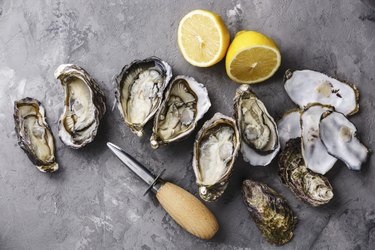
Having cravings for nonfood items — a condition called pica — typically affects young children, especially those with intellectual disabilities. It can also be a symptom of obsessive compulsive disorder and is, less frequently, experienced by pregnant adults.
Nutritional deficiencies may also contribute to your cravings for nonedible substances like baby powder. A visit to your doctor can tell you for sure what nutrients you may be missing, and your doctor can then suggest the proper treatment.
Video of the Day
Video of the Day
What Is Pica?
Pica is an eating disorder characterized by cravings for and consumption of nonnutritive items, such as dirt, clay, paint chips, chalk, glue, paper, sand, metals, charcoal, ice and baby powder. There are many causes of pica, but a common one is deficiency in one or more minerals, including iron, calcium and zinc, according to a case report published in the Journal of International Society of Preventive & Community Dentistry in 2014.
Talc is a naturally occurring mineral. The cravings for substances such as dirt, clay and talc are suspected to be the body's way of attempting to get the minerals it's missing.
Read more: Cravings & Vitamin Deficiencies
Identifying Mineral Deficiencies
Craving or eating baby powder is a sure sign that something isn't right. If there isn't an underlying mental health disorder, it's highly likely that you're deficient in iron, zinc or calcium — or a combination. If so, you may have other symptoms that can reveal more information before you even visit your doctor.
Iron deficiency is common, especially in those who are pregnant or experiencing blood loss from heavy periods. In addition to craving nonfood items, symptoms include:
- Extreme fatigue
- Weakness
- Pale skin color
- Headache and dizziness
- Fast heartbeat and shortness of breath
- Inflamed and sore tongue
- Cold hands and feet
- Brittle nails
If you're low in zinc, you might experience one or more of the following symptoms alongside pica:
- Loss of appetite for food
- Frequently getting sick
- Hair loss
- Diarrhea
- Poor wound healing
- Taste abnormalities
- Mental slowness
People low in calcium may crave nonfood items and experience:
- Muscle cramps
- Confusion
- Depression
- Forgetfulness
- Tingling in lips, fingers and feet
- Stiff, sore muscles
If you're eating baby powder and you have accompanying symptoms matching any of those listed above, there's a good chance they're connected.
Getting the Nutrients You Need
If a blood test comes back showing a mineral deficiency, your doctor may suggest changes to your diet and/or a supplement, depending upon the severity of the deficiency. Knowing how much of each mineral you need each day and which foods are good sources will help you bring your levels back up and keep them there.
The recommended daily allowance (RDA) for iron for men is 8 mg per day. For those who aren't pregnant, the RDA is 18 mg daily. During pregnancy, iron needs increase to 27 mg per day, and during breastfeeding requirements dip to 9 mg per day.
Good dietary sources of iron include:
- Fortified breakfast cereals with 100 percent of daily value for iron: 18 mg per serving
- Oysters: 8 mg in 3 ounces
- Canned white beans: 8 mg per cup
- Beef liver: 5 mg in 3 ounces
- Boiled lentils: 3 mg per 1/2 cup
- Boiled spinach: 3 mg per 1/2 cup
For zinc, the RDA for men is 11 mg, and for women it's 8 mg. During pregnancy, women need 11 mg, and while breastfeeding they need 12 mg each day.
Get your zinc from these rich sources:
- Oysters: 74 mg in 3 ounces
- Beef chuck roast: 7 mg in 3 ounces
- Alaska king crab: 6.5 mg per 3 ounces
- Lobster: 3.4 mg per 3 ounces
- Baked beans: 2.9 mg per serving
Getting enough calcium is crucial at any age, but especially as you get older. The RDA for all adults ages 19 to 50 is 1,000 mg. After age 50, men and women need 1,200 mg daily.
- Plain, low-fat yogurt: 415 mg in 3 ounces
- Part-skim mozzarella: 333 mg per 1.5 ounces
- Canned sardines with bones: 325 mg per 3 ounces
- Cheddar cheese: 307 mg per 1.5 ounce
- Nonfat milk: 299 mg in 8 ounces
Dangers of Eating Baby Powder
Not only is it important from a nutritional perspective to get to the root of your cravings, but it's also critical to protect yourself from cancer and other potential complications caused by eating talcum powder. In April of 2018, Johnson & Johnson was found guilty of selling talc powder products contaminated with asbestos. Johnson & Johnson and other baby powder manufacturers have been sued by thousands of women claiming long-term use of the products caused their ovarian cancers.
Although scientists have not clearly linked the two, ConsumerSafety.org warns consumers to be aware of the risk. Ingesting baby powder could have even more serious risks than topical use. The European Union has gone so far as to ban the use of talc in personal hygiene products.
Read more: Why Do I Crave Salt & Crushed Ice?
- American Pregnancy Association: Pregnancy and Pica
- NEDA: Pica
- Kids Health: Pica
- Journal of International Society of Preventive & Community Dentistry: Eating Everything Except Food (PICA): A Rare Case Report and Review
- NIH: Iron
- NIH: Zinc
- Merck Manual: Hypocalcemia (Low Level of Calcium in the Blood)
- National Academy of Medicine: Dietary Reference Intakes (DRIs): Recommended Dietary Allowances and Adequate Intakes, Elements
- NIH: Calcium
- Consumersafety.org: Talcum Powder and Cancer